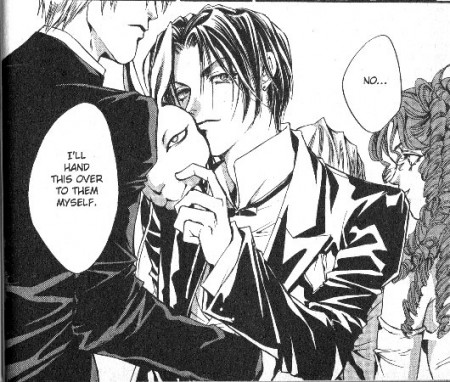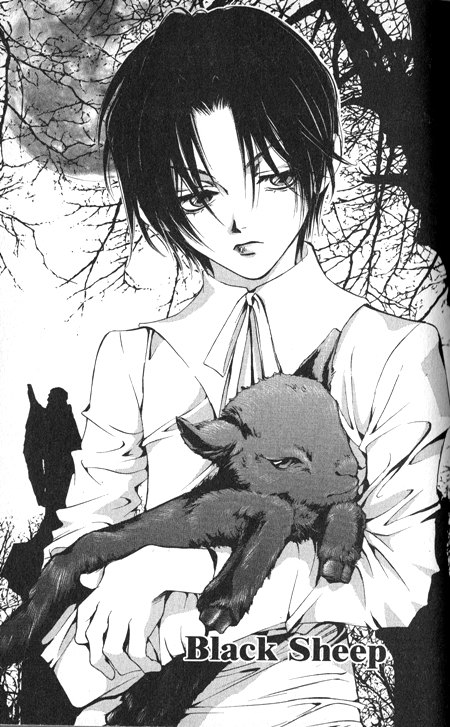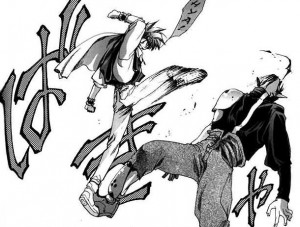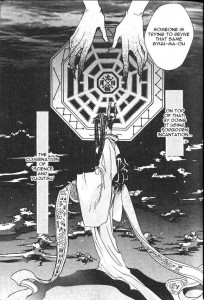Suat has already posted the official selections for best online comics criticism of the year.
To create the final list, each of the judges submitted ten selections. Two judges (Tucker Stone and Frank Santoro have already posted and talked a little about their ten picks. (Matthias Wivel hasn’t weighed in, but may get to it yet. (Update: Ah, there’s Matthias’s piece.)
So in this post I’m going to give the list I submitted to Suat. I’ve arranged it in increasing order of bestness from 10 to 1.
When Suat asked me to act as one of the judges for this project, I initially declined on the reasonable grounds that I don’t necessarily read a ton of comics criticism. I changed my mind on the more half-assed grounds that what the hell — but it remains the case that I am, I’d be willing to bet, far less versed in comics criticism than my fellow judges.
Nonetheless, my choices are, of course, right, and, to the extent that anyone else disagrees with me, they are wrong. So here we go.
Honorable Mentions
If I had more than ten slots, I would have loved to include Shaenon Garrity’s Acme Library #19 koan, Steven Grant’s discussion of why there aren’t more black supervillains, and Jog’s epic discussion of smurfs.
If I were able to vote for my fellow judges, I would have loved to include this amazing piece where Tucker Stone pretends to be Michel Houllebecq. I was also very taken with Matthias Wivel’s review of Kramer’s 7, and with Suat’s discussion of the contribution of artists to super-hero comics.
__________________________
10. Matt Thorn — “On Translation”
As a scholar and a widely respected translator, Thorn’s take on the limitations of current manga translating is riveting. He manages to be both measured and acerbic, a devastating combination — and he also provides some fascinatingly specific examples of translation difficulties and decisions. As is often the case on the Internets, the piece is as worthwhile for the discussion it sparked as for what it initially said. Numerous translators and fans weigh in on the comments thread, with Thorn elaborating thoughtfully on his points. Elsewhere the essay sparked great responses from Simon Jones and Shaenon Garrity.
9. Juan Artega — “The 5 Creepiest Sex Scenes in Comics”
This is what it says on the tin; a Cracked magazine charticle providing a narrative overview, with first-rate snark, of some of the great moments in comics history. Ms. Marvel being turned into the incestuous brain-washed sex slave of her own son and some random bird-guy from the third-rate super-team the Wanderers impregnating a dinosaur are two of the highlights. This is the sort of piece that would provoke Gary Groth to run foaming into the streets shrieking, “See? See? Online comics criticism is shallow trash! I will write a sharp 150,000 word piece attacking it and praising Pauline Kael, thereby bringing capitalism to its knees!” So, you know, as a Marxist, I had to vote for it.
8. Nina Stone — “The Virgin Read: You Need More Janet Jackson in Your Life, Power Girl.”
Nina Stone isn’t a longtime comics reader, but her loving husband (that’s Tucker) is, and he convinced her to write a column about comics from the perspective of someone who doesn’t know or care much about them. The result has been some of the sharpest comics commentary going, focusing mostly on the mediocrity of the mainstream, but occasionally at other outcroppings of comicsdom as well. Nina’s take on Chris Ware, for example, is as perceptive an evaluation of his work as I’ve seen.
Still, despite the greatness that is the Ware review, I pledge my heart to the Power Girl review I’ve selected here. It’s a lovely meditation on men and women and feminism, and whether you can change other people and whether it even makes sense to want to.
Also, it contains the immortal line “Go fly your Power Girl boobies around the world fighting evil.”
7. Robert Stanley Martin — “Comics Review: Chris Claremont & Frank Miller, Wolverine.”
Robert Stanley Martin is a thoughtful, informed, and perceptive critic — but even I have trouble holding that against him when he’s such a fine writer. His take on the Wolverine mini-series begins with a brilliant discussion of alienated characters in the Marvel Universe; how central they are, how they work, and how they really, really don’t. His view of Claremont as a lesser, stumbling Ditko was one of those “oh my god it’s so true!” moments, and his appeciation of the many virtues, as well as the several flaws, of the Claremont/Miller series couldn’t be much more spot on. His review of Alan Moore’s What Ever Happened to the Man of Tomorrow? is also highly recommended.
6. Dirk Deppey — “The Man Who Couldn’t Shoot Straight”
I originally wanted to include Dirk’s skewering of super-hero decadence, but on further consideration I think the hive-mind was right — “The Man Who Couldn’t Shoot Straight,” which made the final list, is really the Deppey piece to pick from this year.
“The Man Who Couldn’t Shoot Straight” is an evisceration of former DC boss Paul Levitz, and a celebration of his firing. It’s a masterful prosecutor’s brief, as well as a lovely example of sustained, sneering contempt. The only thing that ever disappoints me about Dirk’s longer critiques is that there aren’t more of them. I know he’s invaluable as a link-blogger, and HU probably wouldn’t even exist without him, but I can’t help feeling that his talents are a little wasted in pointing to other people writing on comics when he could instead be writing better pieces than anyone himself. I especially miss his actual comics criticism, which is even better, and even rarer, than his industry commentary.
5. Jason Thompson — “Moe: The Cult of the Child”
Jason Thompson wears his vast knowledge of manga extremely lightly. This piece is a case in point; Thompson takes 1000 words or so to provide a thumbnail historical, literary, and moral analysis of manga’s obsession with prepubescent girls. Discussing pedophilia without resorting to exploitation or outrage is an accomplishment in itself; doing it with the grace, humor, and perceptiveness that Thompson manages here is a quiet tour de force.
4.Craig Fischer — “Deep Tezuka”
This is probably the most academic selection on my list — and it pretty much sums up everything that can go right in academic criticism. Fischer uses film theorists (most notably Andre Bazin) and film concepts (“deep focus” — the framing device in movies such as Citizen Kane where everything on screen is in focus) to contrast the experience of viewing a film with that of reading comics in general and Tezuka in particular. The theory background here doesn’t obfuscate, but instead brings into focus (appropriately enough!). Fischer skips lightly through a barrage of cultural and theoretical links, touching on everything from Dan Clowes’ grandmother to the off-color clouds in the Lion King to the film “Best Years of Our Lives,” and on and on and on. It’s dazzling; a real demonstration, not just of knowledge, but of a love of knowledge, and of art.
I’d also highly recommend Fischer’s discussion of repression, anxiety, and hands in the work of Steve Ditko.
3.Tom Crippen — “Age of Geeks”
Tom Crippen blogged at HU for most of 2009. I asked him to join because I love his writing, and working with him regularly only increased my respect for it. He was actually working on “Age of Geeks” through a good portion of the time he was at HU, and little dribs and drabs about it would pop up in offhand remarks here and there. The final result is worth the wait; it’s one of Tom’s absolute best, I think.
It’s also, as it happens, the piece of all of those on the list that I in large part disagree with. I don’t agree that Alan Moore is at core a geek (I think he’s a crank, which is somewhat different.) I don’t agree that geekery is necessarily the ideal metaphor for late capitalism, in part because I don’t entirely agree with Tom’s definition of geekdom (I think it’s more arbitrarily determined — which is why baseball fans and rap fans, for example, don’t really count.) I don’t agree that Moore’s geekery prevented him from treating his characters with respect or fully examining the human condition: on the contrary, I think his willingness *not* to fully explain why Sally loved the Comedian is in many ways the *most* respectful choice he could have made. I don’t believe that Moore’s sentimentality is excessive or forced; I don’t think From Hell is overall a failure.
Those disagreements don’t make me think less of the piece, though. On the contrary. Just looking at that list above you can see how much thought and how many ideas Tom put in here. Even if I don’t entirely acquiesce to the thesis, the idea of geekery as central to modernity, as Tom explains it, isn’t something I had come across before. It set me back; I had to argue with it and figure out if I agreed or not. Similarly, his take on why the Sally/Comedian explanation didn’t work wasn’t something I’d thought through; responding to it in my head actually helped me figure out why I liked Moore’s handling of it so much.
And even if I disagreed on many of the big points, the individual details and insights are just a joy. The image of modern mankind as legs on a caterpillar; the comparison of William Gull and Bruce Banner; the fat tear rolling down Alan Moore’s face; the on point takedown of Watchmen the movie; the brilliant insight about Veidt’s super-power being information processing…the whole thing just bristles with ideas from front to back. It reminds me how much I miss having Tom on the blog to disagree with.
For Tom in a somewhat different mode, you can check out his review of Dykes to Watch Out For at tcj.com.
2. Robert Alter — “Scripture Picture”
This is the only review of American art comics on this list. I noted recently that participating in this best of effort left me feeling that comics criticism of genre work and manga was overall in a healthier state than comics criticism of art comics. This is the exception that proves the rule.
As a Biblical translator, Alter’s knowledge of the Bible is incredible, and following his exegesis is one of the great pleasures of reading his review. He’s also a very fine writer, in a somewhat formal vein, and his descriptions of the Biblical text and of Crumb’s imagery are vivid, thoughtful, and often humorous. This, for example:
In a very different sex scene, when Lot’s two daughters, imagining after the devastation of Sodom that there is no man left for them on earth, get their father drunk so that he can be led to impregnate them, Crumb provides contrasting variations on the sexual act: the elder daughter is shown in the missionary position, evidently enjoying herself, while in another frame the younger daughter bestrides her besotted father, who is still clutching a wineskin, her face turned to one side in an enigmatic expression that might reflect dismay, or an inner distancing from the act, or a kind of solipsistic concentration on it.
I love “bestrides her besotted father.” Plus, I’ll be damned if that isn’t all one sentence. That’s some old-school prose style, that is.
In addition to knowledge and style, though, Alter is graced with a third virtue — lack of reverence. It’s not just that he’s willing to suggest that, in some ways, Crumb is not Lord High Poobah Over All (though don’t get me wrong — I appreciated that a good deal) It’s also that he’s willing to suggest that *comics*, as a medium, may have certain limits.
The point of Alter’s esay, ultimately, is that the ambiguity of the Biblical narrative is simply not something that can be represented through sequential pictographs. This assertion caused a howl of protest from the usual quarters. Tim Hodler argued vociferously that, contra Alter, comics could indeed express ambiguity — an entirely reasonable dissent which was rather undermined by the tone of aggrieved schoolmarmish disappointment in his peers which accompanied it. Tim seemed viscerally irritated that critics “who should know better” might entertain the idea that comics couldn’t do just absolutely everything. Team Comix, Team Comix, — why have you forsaken me! (Update: Tim says, with some justice, that he didn’t say what I said he said. You can read some back and forth in comments.)
I can’t speak for the rest of the team of course. But for myself, I can say, I don’t really need comics to do everything. Comics are a really young art form, developed in a commercial, modern milieu, long after the Bible was written. And given that, it seems to me that, perhaps, form does matter — not just in that you can get to the same place in different ways, but in the sense that you really, truly, can’t necessarily get to the same place at all. This is the point of Craig Fischer’s essay about film vs. comics discussed above. It’s also implicit in a recent essay by Bill Randall, where he notes that comics are uniquely suited to representing fragmentation — and therefore, perhaps, one might argue, less suited to representing the kinds of great, unifying narratives represented by the Bible.
Alter, in short, is willing to talk about what comics can’t do. That willingness to focus on limitations rather than accomplishments is, it seems to me, really important in a critic — and it seems to me too often absent from writing about art comics, where there’s still often, among some critics, a certain level of defensiveness — of trying to prove that comics are serious, already. Which is a shame since, as Alter shows, there’s absolutely no reason that an essay about Crumb’s Genesis can’t be just as good as one about Power Girl or Tezuka or Watchmen.
1. Bill Randall — “Bring the Noise”
I mentioned one of Bill Randall’s essays just above there, and this is that essay. As with Tom, I was lucky enough to get Bill to blog with me on HU for a time. I’ve actually gotten to know him better since he left the blog, and I feel pretty lucky for that too. He’s an incredibly smart and funny observer of comics, and, also, you know, of all that stuff out there that isn’t comics but which still might be important to somebody, I guess.
“Bring the Noise,” which appeared in issue 300 of the Comics Journal, and which is now online at tcj.com, is effectively Bill’s farewell to comics criticism, at least in the short form and at least for a while. It’s a history lesson, a memoir, and a speculation about the potential and the limitations of cross-cultural influence. As with all of Bill’s work, the writing is lovely, and works almost more as poetry than prose — not because the language is flowery, but because the connections it makes are as much about memory, intuition, and rhythms as they are about logic. The way he uses declaratives and often leaves the connections between his insights implicit rather than explicit is almost Emersonian; ideas shimmer through the text, free to form different sparkly patterns. It can be off-putting at first for those like me who are more prosaically minded, but once you get into the rhythm it’s addictive. For example, this paragraph:
One of the main reasons it still makes sense to pay Japan the attention it, as a country long stagnant in politics and economy, no longer deserves, is that it offers a model for contemporary life. What has long been a comfortable place to live has taken to extremes, as with, say, the hikikomori, broken students who avoid the outside world entirely. In some ways Japan seems like a Petri dish for the extremes of urban alienation. And it produces fascinating subcultures. A city like Tokyo has a place for everything as long as it stays where it belongs and doesn’t ruffle any feathers. I find some of the most interesting artists working now speak to some small niche in a minor key. Previously, it was the grand narratives from hugely popular artists. These works addressed a time when worldwide conflict was a living memory and everyone felt its effects. Then Japan became middle-class and fantasies replaced a comfortable, mildly unsatisfying life. Now, everyone’s frittering away in their own individual holes on their own individual things. So group life becomes termite life and each subculture gets its own voice.
I love those last two sentences; the repetition of “individual”, the repetition of “life,” the jump from “holes” to the quick metaphor of “termite,” the way the careful, relatively short sentences of the whole paragraph mirror the sense of individual cultures carefully cocooning. Each time I return to this essay, my respect and affection for it grows.
I can’t find the link, but I’m pretty sure I remember that Bill once mentioned that he’d feel like comics criticism was actually art when a piece made him cry, as film criticism had on occasion. I can’t say this essay made me cry. It’s still beautiful, though.






